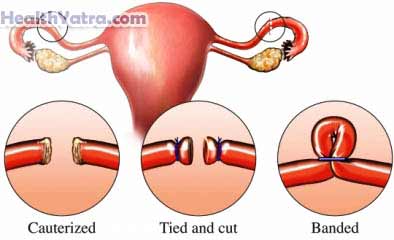Definition
Fallopian tubes are tubes that lead from the ovaries to the uterus. A tubal ligation is a sterilization procedure to close the tubes.

Reasons for Procedure
Tubal ligation is done to prevent pregnancy. If you have this surgery, you will still ovulate and menstruate. The cut or blocked tubes keep the egg and sperm separated. When the egg and sperm cannot meet, fertilization does not happen and pregnancy cannot occur.
This surgery is not recommended as a temporary or reversible procedure. Make sure you consider all the birth control options for you and your partner.
Possible Complications
Problems from the procedure are rare, but all procedures have some risk. Your doctor will review potential problems like:
- Infection
- Bleeding
- Anesthesia-related problems
- Damage to other organs
- Ectopic pregnancy
Some factors that may increase the risk of problems include:
- Smoking
- Obesity
- Previous abdominal surgery
What to Expect
Prior to Procedure
Your doctor will do a physical exam and pregnancy test.
Leading up to your procedure:
- You may need to stop taking some medications up to one week before the procedure, like:
- Nonsteroidal anti-inflammatory drugs, such as ibuprofen or naproxen
- Blood-thinning drugs
- Anti-platelet drugs
- The night before, eat a light meal. Do not eat or drink anything after midnight.
Anesthesia
You may receive one of the following:
- General anesthesia—blocks pain and keeps you asleep through the surgery
- Spinal anesthesia—numbs the area from the chest down to the legs; given as an injection in the back
Description of the Procedure
The doctor will make a small cut in the area of the navel. A harmless gas will then be inserted through this cut and into your abdomen. The gas will inflate the abdominal cavity. This will make it easier for the doctor to see the internal organs. The doctor will then insert a long, thin tool called a laparoscope. This tool will contain a small camera and lighting system, which will let the doctor see inside the abdomen. The doctor may make a second cut just above the pubic hair to insert a tool for grasping the fallopian tubes. The tubes will be closed in one of the following ways:
- Ligation—Tying and cutting of the tube
- Sealing by creating scar tissue
- Removing a small piece of the tube
- Applying plastic bands or clips
The tools will then be removed and the openings will be closed with stitches.
In some cases, the doctor may switch to an open surgery. This involves making a larger incision.
Immediately After Procedure
You will be brought into the recovery room. You will rest there until the anesthesia wears off. You may receive pain medication.
How Long Will It Take?
20-30 minutes
How Much Will It Hurt?
Anesthesia will keep you comfortable and pain free during the procedure. You may feel bloated and have pain in your shoulder or chest because of the air inserted into your abdomen. Ask your doctor about medication to help with the pain after the procedure.
Post-procedure Care
At the Care Center
You can usually go home the same day. You may need to stay longer if you have complications.
At Home
To help ensure a smooth recovery:
- Follow your doctor’s instructions on cleaning the incision site.
- Ask your doctor about when it is safe to shower, bathe, or soak in water.
- Be sure to follow your doctor’s instructions.
Call Your Doctor
Call your doctor if any of the following occur:
- Signs of infection, including fever and chills
- Redness, swelling, increasing pain, excessive bleeding, or discharge from the incision sites
- Severe and continuous abdominal pain
- Nausea and vomiting lasting more than a day
- Cough, shortness of breath, or chest pain
- Lightheadedness or fainting
- Pain and or swelling in one or both legs
- Heavy vaginal bleeding after the first day
- Missed menstrual period
If you have an emergency, call for medical help right away.
